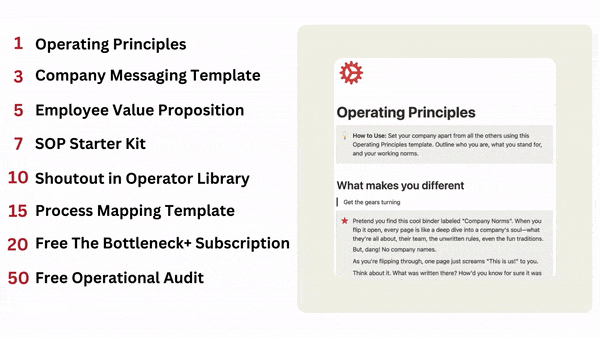
Read Time: 3.8 Minutes
Happy Sunday Operators ⚙️
Surprised to see me on the weekend?
Don’t be.
I have something cooking that I wanted to share with you.
Lean in close.
I wanted to give you a sneak peek of what to expect in the case studies every weekend if you upgrade your subscription plan.
If you sign up, you will get a discounted rate on:
Analysis of 1 case study every weekend to learn how the best have scaled
Documents of the lessons from 50+ of the world's best business leaders
Access to a telegram community to talk shop
First dibs on operational templates and artifacts so you can avoid reinventing the wheel
AI tools to smooth out your operations
I plan to launch all these out over the quarter. As each item launches, I'll be raising the price.
Want to lock in your price? Click down below to get started.
Now that we got that done, let's dive into today's strategy breakdown.
Why would Superhuman manually onboard their customers if they only pay $30/month?

What is SuperHuman?
Superhuman is Gmail on steroids - faster, prettier, and easy to use.
The minimalistic design, AI email sorting, and keyboard shortcuts help you zoom through your inbox.
Using Superhuman almost feels like playing a game to get your inbox to zero.
Here’s David Ulevitch from Andreessen Horowitz explaining why people love it:
Once I started using Superhuman, the idea of using anything else melted away. You don’t realize how slow Gmail is until you use an experience focused on speed. Since the product is meticulously crafted, everything happens in 100ms, or less; everything from search to triage and response is blazingly fast. Every element of Superhuman helps you move faster, stay in flow, and experience joy.
To get access, you must go through a 30-minute onboarding call to get the privilege to pay for it.
And the craziest part about all this? Superhuman is only $30 a month!
Why would Superhuman go through the trouble of jumping on a call and onboarding a customer for only $30 a month?
Why not go the self serve route like Notion?

Why should you care?
Onboarding can be a great marketing instrument
Superhuman has turned collecting emails to maintain long-term demand into a trend.
In the startup realm, limiting growth to accept paying customers is unusual.
Superhuman uses exclusivity to manage growth, detailed onboarding, and heighten customer interest.
Onboarding isn't just a process; it's a key marketing strategy. Integrating marketing and growth with the product enhances the whole product experience.
Superhuman has carved out a niche with its premium product in a market dominated by free email services. They've marketed to founders, managers, and executives to a valuation of around $2 billion.
Personalizing the onboarding process slows acquisition but leads to better user loyalty. Superhuman exemplifies this approach with extra growth advantages:
Creating a Memorable Experience: Imagine the CEO onboarding you for an hour. Such a human touch is delightful in a world accustomed to automated onboarding and impersonal emails. This kind of positive surprise leads people to share their experiences with others.
Standing Out as a Product: Unlike mainstream options like Gmail, Outlook, and other B2C startups, Superhuman's manual onboarding approach sets it apart. This distinctiveness reinforces its unique market position.
Attracting Media Attention: Superhuman gained early media attention through its standout user experience. Garnering the press's and influencers' interest in the tech space is an effective way to amplify a viral growth cycle.
Fueling Viral Growth: The story of Superhuman's onboarding sparked viral growth. The novelty created a viral cycle fueled by user testimonials, media attention, and influencer interest. The strategy of granting access only post-onboarding added an element of exclusivity.
Their method adds friction, but it has resulted in a large waiting list and high demand.

How do you do this?
Superhuman has a special way of welcoming new users. They start with a quiz, and the answers help a real person from Superhuman decide if you're the right fit. Then, they chat with you for 30 minutes to get to know you better.
Their onboarding has five main goals:
1. Grow with the Right Users: They focus on getting users who really need Superhuman and will stick with it. It's about having quality users, not just a lot of them.
2. Understand Their Users: Every time they talk to a new user, it's like an interview. This helps them stay updated on what users like, need, and how they use other similar products.
3. Help Users Become Experts Fast: When a Superhuman team member shows you how to use their product, you learn quicker. This means you'll get better at using it and likely keep using it.
4. Make Users Feel Special: Spending 30 minutes talking to you makes you feel important and connected to Superhuman. This feeling probably makes a lot of users stick around.
5. Get People Talking: The unique way Superhuman brings in new users is interesting to talk about. I heard about it from my COO buddy and am now sharing it too. This helps more people find out about Superhuman.
So, Superhuman's way of bringing in new users is more than just a welcome. It's a big part of why people like and keep using their service.
Rahul, the founder of Superhuman, was the one who welcomed the first 200 users himself.
Here's what he did in their early days to introduce people to Superhuman:
Show Off Superhuman: He gave a full tour of Superhuman, pointing out what's really cool and fun about it.
Talk About the Cost: He reminded them that Superhuman isn't free, it's a special, paid service. He also used the Van Westendorp Test to see how much they'd be willing to pay.
Learn About Their Email Habits: He asked users how they usually handle their emails and noted how Superhuman could help them specifically.
Demonstrate Faster Email Handling: He showed them how to manage their emails with Superhuman in half the time they usually take.
Email Together for 30 Minutes: They had to do emails together for half an hour. While doing this, Rahul would find small issues, or 'bugs', to tell his team about. They aimed to fix these issues within a week to keep improving.
Send a Thank You Gift: Rahul would send a personal gift, like a bottle of wine or whiskey, to thank them for their time. This got harder to do as the number of users grew into the thousands.
Initially, Rahul's approach was a big part of how Superhuman made its users feel special and helped the product improve.
Check out this onboarding survey template that mirrors Superhuman’s.

Spread The Word
Share The Bottleneck with friends to get a few freebies. Maybe you’ll make some new friends along the way 😆
We’ll give you free stuff and more friends if you share a link. Only one link.

{{rp_personalized_text}}

